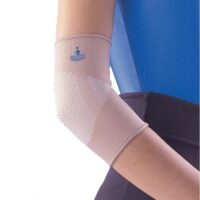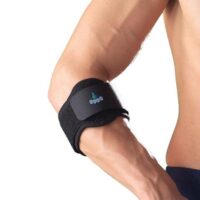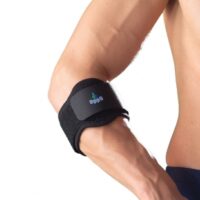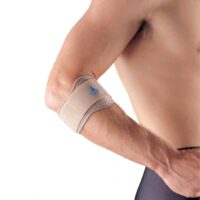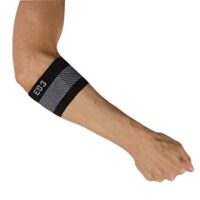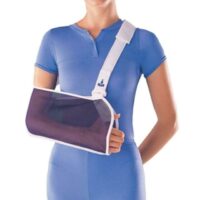Tennis Elbow
Article by John Miller
Tennis Elbow: Lateral Epicondylalgia

Why Does Tennis Elbow Occur?
Tennis elbow, medically known as lateral epicondylalgia, arises from overuse of the forearm muscles and tendons, leading to pain on the outer part of the elbow. This condition, often exacerbated during gripping tasks or when extending the wrist and fingers against resistance, is common in both athletes and manual workers. Despite its name, you don’t need to play tennis to suffer from this condition. But why does this occur?
How Does Tennis Elbow Develop?
Tennis elbow typically results from repetitive strain. This strain causes micro-tears in the tendons that attach the forearm muscles to the outer elbow. Over time, these micro-tears lead to inflammation and pain. Acute cases often stem from a sudden increase in activity, while chronic cases may develop due to ongoing wear and tear, leading to degenerative changes in the tendons. If left untreated, it can significantly impact your daily activities, causing ongoing pain and weakness in the elbow and hand.
Who Is at Risk?
While tennis elbow can affect anyone, those engaged in repetitive manual work or sports are particularly at risk. It’s not limited to tennis players; plumbers, painters, builders, and even office workers who spend long hours typing are susceptible. The condition is most prevalent in individuals aged 30 to 50, but it can occur at any age.
What Is the Solution?
Early Intervention: Why It’s Essential
Addressing tennis elbow early with a physiotherapist’s guidance is crucial. Physiotherapy offers tailored treatment strategies, including specific exercises, mobilisations, and supportive braces that can alleviate pain and prevent further damage. Early intervention can lead to significant improvement within weeks, while ignoring the symptoms may result in prolonged discomfort and reduced function. Read more on the importance of early intervention here.
Diagnosis: How Do You Identify Tennis Elbow?
Diagnosing tennis elbow isn’t just about identifying pain in the elbow. A thorough assessment by a physiotherapist is essential, which may include physical examinations, ultrasound, or MRI scans to determine the extent of tendon damage. It’s also critical to differentiate between tennis elbow and neck-related pain, as each requires a different treatment approach.
What Are the Treatment Options?
The Role of Physiotherapy
Physiotherapy remains the cornerstone of treatment for tennis elbow. Through a combination of manual therapy, exercise prescription, and education, physiotherapists help patients regain strength, flexibility, and function. While cortisone injections might offer quick relief, they often mask the problem and can hinder long-term recovery. Physiotherapy, on the other hand, addresses the root cause and provides sustainable results. Explore physiotherapy options here.
Bracing for Support
Using a tennis elbow brace can alleviate mild symptoms and prevent recurrence during repetitive activities. However, if pain persists, it’s vital to consult a physiotherapist for a comprehensive evaluation and a tailored treatment plan. Braces are not a cure but a helpful tool in a broader treatment strategy. Read more about the use of Tennis elbow braces here.
Comparing Injection Effectiveness
Recent studies compare the effectiveness of corticosteroid injections, physiotherapy, and placebo in treating tennis elbow. While injections might offer temporary relief, physiotherapy has shown superior results in achieving long-term recovery. (Coombes et al, 2013)
What Does the Latest Research Say?
Conclusion: Embrace Professional Care
Tennis elbow can be a debilitating condition, but with the right approach, recovery is within reach. Physiotherapy offers a proven pathway to recovery, emphasising tailored treatment strategies that address the underlying causes. Don’t let tennis elbow rule your life—consult a physiotherapist and start your journey to recovery today.
What to Do?
If you’re experiencing symptoms of tennis elbow, seek professional advice from your physiotherapist. Early intervention can make all the difference in your recovery. Book an appointment today to get started on a treatment plan tailored to your needs.
Rochedale - Call 38410277
Book Online: RochedaleSalisbury - Call 32751044
Book Online: SalisburySandgate - Call 32691122
Book Online: Sandgate
Tennis Elbow FAQs
1. What is Tennis Elbow? Tennis elbow, or lateral epicondylalgia, is a condition that causes pain on the outer part of the elbow due to overuse of the forearm muscles and tendons.
2. How is Tennis Elbow Diagnosed? Diagnosis involves a physical examination, and sometimes imaging tests like ultrasound or MRI, to assess the extent of tendon damage. Differentiating it from other conditions is crucial.
3. What Are the Symptoms of Tennis Elbow? Symptoms include pain and tenderness on the outer elbow, especially during gripping or extending the wrist. The pain may worsen with repetitive activities.
4. How is Tennis Elbow Treated? Treatment options include physiotherapy, exercise, bracing, and sometimes corticosteroid injections. Physiotherapy is often the most effective for long-term recovery.
5. Can Tennis Elbow Be Prevented? Yes, by avoiding repetitive strain, using proper technique in activities, and strengthening the forearm muscles, tennis elbow can often be prevented.
6. How Long Does It Take to Recover from Tennis Elbow? Recovery time varies but with early intervention and proper treatment, significant improvement is often seen within weeks. Chronic cases may take longer.
Social Media – Follow Us for Free Tips
Stay updated with practical tips on managing tennis elbow by following us on social media. Our posts provide valuable advice to help you stay on top of your health.
Related Articles
- Golfer’s Elbow (Medial Epicondylitis): Discusses a similar condition affecting the inside of the elbow.
- Elbow Pain: Offers a broad overview of elbow pain causes, including tennis elbow.
- Wrist Pain: Explains how wrist pain can accompany or result from tennis elbow.
- Tennis Elbow Brace: Discusses how braces can help alleviate symptoms and prevent recurrence.
- Corticosteroid Injections for Elbow Pain: Compares injections with other treatment options like physiotherapy.
- Physiotherapy for Elbow Injuries: A deeper look into physiotherapy treatments for elbow injuries.
- Chronic Pain Management: Discusses strategies for managing chronic pain, including tennis elbow.
- Exercise Programs for Tendon Rehabilitation: Offers specific exercises for tendon recovery, relevant to tennis elbow.
- Neck Pain and Elbow Pain Connection: Discusses how neck issues can cause elbow pain, sometimes mistaken for tennis elbow.
- Manual Therapy Techniques for Elbow Pain: Explores various manual therapy techniques for treating elbow pain.
- Understanding and Managing Tennis Elbow: Provides an in-depth guide to tennis elbow, including symptoms,





















